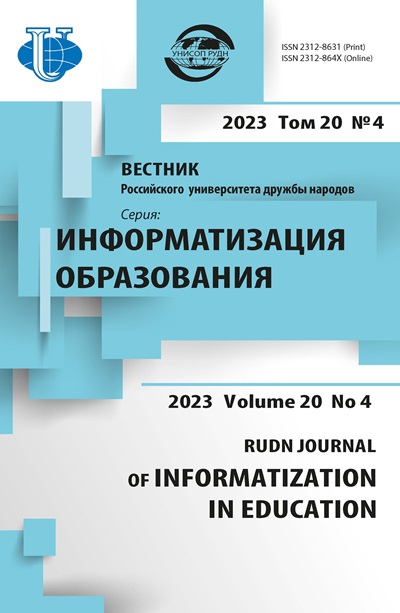Application of virtual reality technology in inclusive education of persons with complete or partial lower limb injury
- Authors: Aslanov R.E.1, Bolshakov A.A.2, Grinshkun A.V.3
-
Affiliations:
- National Research University Higher School of Economics
- Peter the Great St. Petersburg Polytechnic University
- Institute of Correctional Pedagogy of the Russian Academy of Education
- Issue: Vol 19, No 3 (2022)
- Pages: 208-223
- Section: DIGITAL TECHNOLOGY FOR INCLUSION
- URL: https://journals.rudn.ru/informatization-education/article/view/32257
- DOI: https://doi.org/10.22363/2312-8631-2022-19-3-208-223
Cite item
Full Text
Abstract
Problem and goal. The annual growth in the number of people with disabilities determines the relevance of the problems of inclusive education, the solution of which requires new teaching aids that are more interactive and visual than classical tools. This problem necessitates the use of innovative solutions, one of which is the use of virtual reality technology as a way of interactive communication of information and a comfortable environment for students with disabilities. Methodology. The main object of the study is an immersive virtual simulator designed for teaching disabled students in a technical direction. Using the example of the simulator, a solution for interactive and comfortable for perception transfer of knowledge in the specialty is demonstrated. The analysis of the number of persons with disabilities and the number of students with disabilities in secondary vocational and higher education was carried out using open sources, such as sfri.ru and rosstat.gov.ru. Results. Definitions are given for understanding the essence of virtual reality technology and solutions, in the form of simulators suitable as simulators with a unique approach to information perception. Consideration of the developed immersive virtual simulator for the maintenance of personal computers in a broad context allowed us to reflect the features of the application of innovative solutions for inclusive education. Conclusion. In the process of carrying out research work using various means of analysis virtual simulator, the main areas of application of virtual reality for people with disabilities are considered and appropriate conclusions are drawn about the use of virtual reality technology in inclusive education.
About the authors
Roman E. Aslanov
National Research University Higher School of Economics
Author for correspondence.
Email: aslanov.boxing@mail.ru
ORCID iD: 0000-0001-7904-3801
undergraduate, Institute of Education
16 Potapovskii Pereulok, bldg 10, Moscow, 101000, RussiaAlexander A. Bolshakov
Peter the Great St. Petersburg Polytechnic University
Email: aabolshakov57@gmail.com
ORCID iD: 0000-0001-7966-718X
Doctor of Technical Sciences, Professor of the Higher School of Artificial Intelligence, Institute of Computer Science and Technology
29 Politekhnicheskaya St, bldg 4, St. Petersburg, 195251, RussiaAleksandr V. Grinshkun
Institute of Correctional Pedagogy of the Russian Academy of Education
Email: grinshkun@ikp.email
ORCID iD: 0000-0003-3882-2010
Candidate of Pedagogical Sciences, Associate Professor of the Russian Academy of Education, Deputy Director for Development and Informatization Programs Institute
8 Pogodinskaya St, bldg 1, Moscow, 119121, RussiaReferences
- Dudyrev FF, Maksimenkov OV. Simulators and trainers in vocational education: pedagogical and technological aspects. Educational Studies Moscow. 2020;(3):255–276. (In Russ.)
- Qingyang I, Qian L, Ziwei L, Shen J. Virtual reality or video-based self-instruction: comparing the learning outcomes of cardiopulmonary resuscitation training. Bulletin of the South Ural State University. Series: Education. Educational Sciences. 2021; 13(2):53–62. http://doi.org/10.14529/ped210205
- Fedchenko AD. Virtual reality in modern technologies of vocational education. Bulletin of Young Scientists and Specialists of Samara University. 2020;(2):43–49. (In Russ.)
- Merkulov IA, Sinelnikov AO. Virtual reality. Trends in the Development of Science and Education. 2019;(50–1):64–67. (In Russ.)
- Sushkevich AS, Mashkov KN. Education of the future: augmented and virtual reality in the study of professional cycle subjects. Digital Transformation of Education: Electronic Collection of Abstracts of the 1st Scientific and Practical Conference. Minsk; 2018. p. 315–319. (In Russ.)
- Jose EG. Virtual reality and education. Modern Foreign Psychology. 2021;10(3):68–78. (In Russ.)
- Soboleva EV, Suvorova TN, Grinshkun AV, Bocharov MI. Applying gamification in learning the basics of algorithmization and programming to improve the quality of students’ educational results. European Journal of Contemporary Education. 2021;10(4):987–1002. https://doi.org/10.13187/ejced.2021.4.987
- Dawley L, Dede C. Situated learning in virtual worlds and immersive simulated. Handbook of Research on Educational Communications and Technology. 4th ed. Springer: New York; 2017. p. 723–734. https://doi.org/10.1007/978-1-4614-3185-5_58
- Mmaki J, Trevor M, Ronel M. Experiential learning through virtual and augmented reality in higher education. Available from: https://drive.google.com/file/d/1B5iDxLP4FFMudwGGXjzBCmjcMUsyVmCY/view?usp=sharing (accessed: 04.05.2022).
- Bolshakov AA, Sgibnev AA, Veshneva IV, Grepechuk YN, Klyuchikov FV. System analysis human-machine interaction based on status functions in the formation of a three-dimensional image in volumetric displays. News SPbGTI(TU). 2017;(40):102–110. (In Russ.)
- Bolshakov AA, Vishtak OV, Frolov DA. Formation of a training course model of an interactive computer training system based on a fuzzy cognitive map. Bulletin of the Astrakhan State Technical University. Series: Management, Computer Engineering and Informatics. 2016;(2):92–99. (In Russ.)
- Bolshakov AA, Klyuchikov AV, Kovylov NV. Building a system architecture for displaying data in a complex of output devices. 2020 International Conference on Actual Problems of Electron Devices Engineering (APEDE). IEEE; 2020. p. 302–304. http://doi.org/10.1109/APEDE48864.2020.9255414
- Bolshakov AA, Klyuchikov AV. Decision support system for selecting designs of autostereoscopic displays. Cyber-Physical Systems: Design and Application for Industry 4.0. 2021;342:73–88. https://doi.org/10.1007/978-3-030-66081-9_6
- Klyuchikov AV, Bolshakov AA. Functional modeling of the process of constructing volumetric images based on autostereoscopic displays. Caspian Journal: Management and High Technologies. 2019;(2):41–59. (In Russ.)
- Chugunkov IV, Kabak DV, Vyunnikov VN, Aslanov RE. Creation of datasets from open sources. EIConRus-2018 Conference of Russian Young Researchers in Electrical and Electronic Engineering. IEEE; 2018. p. 295–297.
- Gaibatova AR, Aslanov RE, Krylov GO, Konev VN. Development of a method for data synchronization and encryption. Informatization and Communication. 2017;(4): 77–80. (In Russ.)
- Aslanov RE, Shikunov DR, Fomina OV. Application of “virtual reality” in education. Digitalization of Society: State, Problems, Prospects: Proceedings of VIII Annual All-Russian Scientific and Practical Conference. Moscow: Plekhanov Russian University of Economics; 2021. p. 146–158. (In Russ.)
















